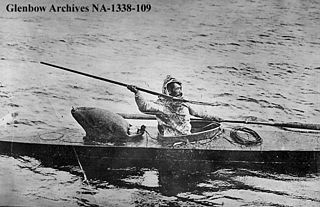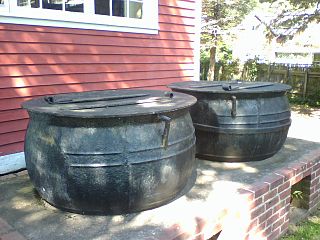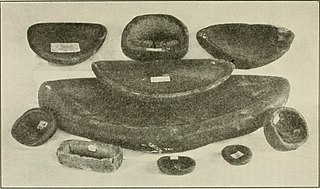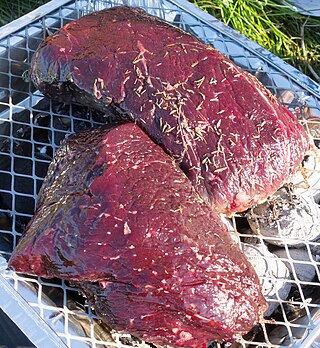Blubber is a thick layer of vascularized fat found under the skin of all cetaceans, pinnipeds, and sirenians.
Blubber may also refer to:
Blubber is a thick layer of vascularized fat found under the skin of all cetaceans, pinnipeds, and sirenians.
Blubber may also refer to:

Judith Blume is an American writer of children's, young adult and adult fiction. Blume began writing in 1959 and has published more than 25 novels. Among her best-known works are Are You There God? It's Me, Margaret (1970), Tales of a Fourth Grade Nothing (1972), Deenie (1973), and Blubber (1974). Blume's books have significantly contributed to children's and young adult literature.

Blubber is a thick layer of vascularized adipose tissue under the skin of all cetaceans, pinnipeds, penguins, and sirenians.

A harpoon is a long spear-like instrument and tool used in fishing, whaling, sealing, and other marine hunting to catch and injure large fish or marine mammals such as seals and whales. It accomplishes this task by impaling the target animal and securing it with barb or toggling claws, allowing the fishermen to use a rope or chain attached to the projectile to catch the animal. A harpoon can also be used as a weapon. Certain harpoons are made with different builds to perform better with the type of target being aimed at. For example, the Inuit have short, fixed foreshaft harpoons for hunting seals at their breathing holes while loose shafted ones are made for attaching to the game thrown at.

Whaling in the Faroe Islands, or grindadráp, is a type of drive hunting that involves herding various species of whales and dolphins, but primarily pilot whales, into shallow bays to be beached, killed, and butchered. Each year, an average of around 700 long-finned pilot whales and several hundred Atlantic white-sided dolphins are caught over the course of the hunt season during the summer.

There have been several cases of exploding whale carcasses due to a buildup of gas in the decomposition process. This would occur if a whale decides to strand itself ashore. Actual explosives have also been used to assist in disposing of whale carcasses, ordinarily after towing the carcass out to sea, and as part of a beach cleaning effort. It was reported as early as 1928, when an attempt to preserve a carcass failed due to faulty chemical usages.

A trywork, located aft of the fore-mast, is the most distinguishing feature of a whaling ship.
Whale oil is oil obtained from the blubber of whales. Whale oil from the bowhead whale was sometimes known as train oil, which comes from the Dutch word traan.
Blibber-Blubber was the first bubble gum formulation, developed in 1906 by American confectioner Frank H. Fleer. The gum was brittle and sticky, with it containing little cohesion; for these reasons, the gum was never marketed. It also required vigorous rubbing with a solvent to remove from the face after the bubble had burst.

Blubber is a children's novel by Judy Blume first published in 1974. The narrator of the story is Jill Brenner, a Pennsylvania fifth-grader who joins her classmates in ostracizing and bullying Linda, an awkward and overweight girl. Linda gives an oral class report about whales and is hence nicknamed "Blubber" by her peers.

Muktuk is a traditional food of the peoples of the Arctic, consisting of whale skin and blubber. It is most often made from the bowhead whale, although the beluga and the narwhal are also used. It is usually consumed raw, but can also be eaten frozen, cooked, or pickled.

Flensing is the removing of the blubber or outer integument of whales, separating it from the animal's meat. Processing the blubber into whale oil was the key step that transformed a whale carcass into a stable, transportable commodity. It was an important part of the history of whaling. The whaling that still continues in the 21st century is both industrial and aboriginal. In aboriginal whaling the blubber is rarely rendered into oil, although it may be eaten as muktuk.
Spic is an ethnic slur for a person of Latino/Hispanic descent.

A try pot is a large pot used to remove and render the oil from blubber obtained from cetaceans and pinnipeds (seals), and also to extract oil from penguins. Once a suitable animal such as a whale had been caught and killed, the blubber was stripped from the carcass in a process known as flensing, cut into pieces, and melted in the try pots to extract the oil.

Historically Inuit cuisine, which is taken here to include Greenlandic cuisine, Yup'ik cuisine and Aleut cuisine, consisted of a diet of animal source foods that were fished, hunted, and gathered locally. In the 20th century the Inuit diet began to change and by the 21st century the diet was closer to a Western diet. After hunting, they often honour the animals' spirit by singing songs and performing rituals. Although traditional or country foods still play an important role in the identity of Inuit, much food is purchased from the store, which has led to health problems and food insecurity.

The qulliq, is the traditional oil lamp used by Arctic peoples, including the Inuit, the Chukchi and the Yupik peoples.

Whale meat, broadly speaking, may include all cetaceans and all parts of the animal: muscle (meat), organs (offal), skin (muktuk), and fat (blubber). There is relatively little demand for whale meat, compared to farmed livestock. Commercial whaling, which has faced opposition for decades, continues today in very few countries, despite whale meat being eaten across Western Europe and colonial America previously. However, in areas where dolphin drive hunting and aboriginal whaling exist, marine mammals are eaten locally as part of a subsistence economy: the Faroe Islands, the circumpolar Arctic, other indigenous peoples of the United States, St. Vincent and the Grenadines, some of villages in Indonesia and in certain South Pacific islands.
Blubber Bay is an unincorporated settlement on the northern end of Texada Island at the bay of the same name in the northern Gulf of Georgia on the South Coast of British Columbia, Canada. The ferry from Powell River docks at Blubber Bay, which sits beside quarry offices, pits and workings which stretch up the hill. The north rim of the bay has the disused workings of BC Cement Company with dock, work area, and various pits stretching out to the headland. There is a museum and archives and a small store located above the ferry landing.

Important parts of Faroese cuisine are lamb and also fish owing to proximity to the sea. Traditional foods from the Faroe Islands include skerpikjøt, seafood, whale meat, blubber, garnatálg, Faroese puffins, potatoes, and few fresh vegetables.

Marine mammals are a food source in many countries around the world. Historically, they were hunted by coastal people, and in the case of aboriginal whaling, still are. This sort of subsistence hunting was on a small scale and produced only localised effects. Dolphin drive hunting continues in this vein, from the South Pacific to the North Atlantic. The commercial whaling industry and the maritime fur trade, which had devastating effects on marine mammal populations, did not focus on the animals as food, but for other resources, namely whale oil and seal fur.

Seal meat is the flesh, including the blubber and organs, of seals used as food for humans or other animals. It is prepared in numerous ways, often being hung and dried before consumption. Historically, it has been eaten in many parts of the world, both as a part of a normal diet, and as sustenance.